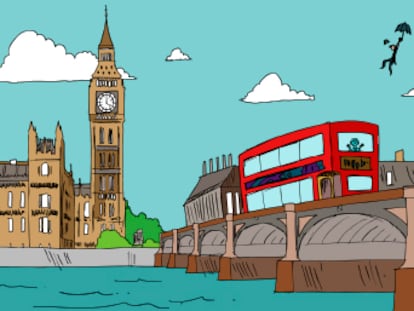Fear of being turned away and aversion to Trump: US tourism industry braces for fall in international visitors
Following reports of travelers being detained or denied entry, along with the president’s increasingly fiery rhetoric, tourist numbers have dropped, and one study estimates it could lead to billions of dollars in lost revenue

A scientist allegedly denied entry to the United States after border agents found critical messages about President Trump on his phone. A British punk band turned back at Los Angeles International Airport without a clear explanation. A Welsh backpacker detained at the Canadian border and, according to her testimony, mistreated for three weeks because her visa did not match the purpose of her trip.
Cases like these have been coming to light in recent weeks. The Trump administration’s aggressiveness toward its supposed European allies, its increasingly transparent intentions to annex Greenland, the incipient start of a global trade war, as well as the polarizing rhetoric on immigrants, foreigners, the LGBTQ+ community, and other minorities are already having an impact on the number of international tourists in the country. And the forecasts, conservative as they do not yet account for all factors, depict a bleak outlook with billions of dollars in lost revenue.
Even before reports of tourist detentions and deportations from countries that previously had no trouble entering the United States, forecasts had already predicted a decline in international tourism. A study by Tourism Economics, a think tank affiliated with Oxford University, published in late February and focused on the impact of the trade war, estimated that foreign visits would decline by 5% year-over-year due to the Trump administration’s “polarizing policies and rhetoric.”
Earlier forecasts from late December, just a month before Donald Trump’s inauguration, had projected a 9% increase. According to the study, the economic impact of this decline could reach at least $64 billion annually, as international travelers tend to spend significantly more than domestic tourists.
This downturn is already visible. According to preliminary data from the National Travel and Tourism Office, international tourist arrivals dropped 2.4% in February compared to the same month the previous year. These figures exclude travelers from Canada and Mexico, the two largest sources of international visitors, followed by Western Europe. However, Canadian data paints an even grimmer picture: the number of Canadians returning from the U.S. by land fell by 23%, while air travel saw a 13% decline.
Canadians have perhaps responded most negatively to Trump, particularly after his repeated remarks about making Canada the 51st state. This summer, that sentiment is translating into a 32% increase in Canadian bookings for vacation properties in Europe, according to Key Data, a short-term rental analytics firm. A similar trend is expected in reverse, with Europeans opting for Canada over the United States as their travel destination.
European tourism to the U.S. generates an estimated $155 billion in annual revenue, according to European Union data. The first signs of decline appeared in February, with a 1% drop compared to the previous year. However, the decline is expected to be steeper in March, as multiple countries have updated travel advisories or issued warnings to their citizens about visiting the United States. For example, Norway’s Ministry of Foreign Affairs cautioned travelers: “ESTA [Electronic System for Travel Authorization] or visa does not guarantee entry. The immigration authorities upon arrival make the final decision. Norwegian authorities cannot intervene in this decision.”
In addition, several European countries — starting with Denmark last Thursday — have advised transgender citizens to list their gender assigned at birth on travel documents, as the U.S. only recognizes those genders. Others have recommended that transgender travelers consult the U.S. embassy to clarify their status.
According to several reports, European travel agencies are noticing declining interest in trips to the United States, and transatlantic flight searches have dropped. The political climate is the primary deterrent, though the strengthening U.S. dollar, which has made travel more expensive, is also a factor.
Historical data underscores how trade and geopolitical tensions impact tourism demand. During the previous U.S.-China trade conflict under Trump’s first term, the U.S. share of the Chinese tourism market fell significantly. Similarly, strained relations with Mexico in past years led to a 3% decline in visitors from the southern neighbor.
In an already challenging post-pandemic global economy, the U.S. was struggling to attract foreign tourists. By 2024, international visitor numbers remained 9% below 2019 levels, with particularly low arrivals from China and Japan. If the tourism outlook seemed uncertain before, Trump’s escalating rhetoric and policy decisions are making it even bleaker.
Sign up for our weekly newsletter to get more English-language news coverage from EL PAÍS USA Edition
Tu suscripción se está usando en otro dispositivo
¿Quieres añadir otro usuario a tu suscripción?
Si continúas leyendo en este dispositivo, no se podrá leer en el otro.
FlechaTu suscripción se está usando en otro dispositivo y solo puedes acceder a EL PAÍS desde un dispositivo a la vez.
Si quieres compartir tu cuenta, cambia tu suscripción a la modalidad Premium, así podrás añadir otro usuario. Cada uno accederá con su propia cuenta de email, lo que os permitirá personalizar vuestra experiencia en EL PAÍS.
¿Tienes una suscripción de empresa? Accede aquí para contratar más cuentas.
En el caso de no saber quién está usando tu cuenta, te recomendamos cambiar tu contraseña aquí.
Si decides continuar compartiendo tu cuenta, este mensaje se mostrará en tu dispositivo y en el de la otra persona que está usando tu cuenta de forma indefinida, afectando a tu experiencia de lectura. Puedes consultar aquí los términos y condiciones de la suscripción digital.
More information
Archived In
Últimas noticias
All the effects of gentrification in one corner of Mexico’s Colonia Roma
Palestinian reporter Youmna El Sayed: ‘My family told me I had to choose between being a journalist or a mother’
Christmas loses its festive spirit: ICE fears cast shadow over religious celebrations
The new language of the workplace: Knowing how to ask AI questions is more important than using it
Most viewed
- The low-cost creative revolution: How technology is making art accessible to everyone
- Families demand repatriation of bodies of Colombians who died in Ukraine: ‘This war is a slaughterhouse for foreigners’
- Christian Louboutin: ‘Young people don’t want to be like their parents. And if their parents wear sneakers, they’re going to look for something else’
- US sanctions against jailed cartel leader ‘El Marro’ highlight Mexico’s lack of control over its prisons
- Liset Menéndez de la Prida, neuroscientist: ‘It’s not normal to constantly seek pleasure; it’s important to be bored, to be calm’











































